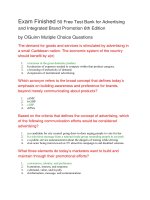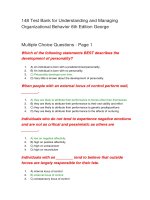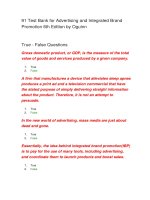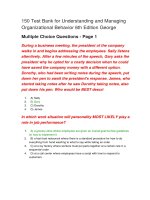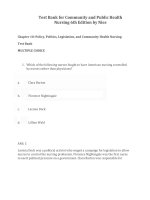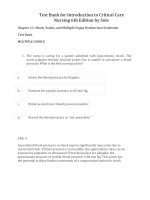Test bank for leading and managing in nursing 6th edition by yoder wise download
Bạn đang xem bản rút gọn của tài liệu. Xem và tải ngay bản đầy đủ của tài liệu tại đây (185.99 KB, 16 trang )
Test Bank for Leading and Managing in Nursing 6th Edition by Yoder Wise
Chapter 01: Leading, Managing, and Following
Yoder-Wise: Leading and Managing in Nursing, 6th Edition
MULTIPLE CHOICE
1. A nurse manager of a 20-bed medical unit finds that 80% of the
patients are older adults. She is asked to assess and adapt the
unit to better meet the unique needs of the older adult patient.
Using complexity principles, what would be the best approach
to take in making this change?
a. Leverage the hierarchical management position
to get unit staff involved in assessment and
planning.
b. Engage involved staff at all levels in the decision-making
process.
c. Focus the assessment on the unit, and omit
the hospital and community environment.
d. Hire a geriatric specialist to oversee and control the project.
ANS: B
Complexity theory suggests that systems interact and adapt
and that decision making occurs throughout the systems, as
opposed to being held in a hierarchy. In complexity theory,
every voice counts, and therefore, all levels of staff would be
involved in decision making.
REF: Page 8 TOP: AONE competency: Communication and
Relationship-Building
2. A unit manager of a 25-bed medical/surgical area receives a
phone call from a nurse who has called in sick five times in the
past month. He tells the manager that he very much wants to
come to work when scheduled but must often care for his wife,
who is undergoing treatment for breast cancer. According to
Maslow’s need hierarchy theory, what would be the best
approach to satisfying the needs of this nurse, other staff, and
patients?
a. Line up agency nurses who can be called in to work on short
notice.
b. Place the nurse on unpaid leave for the remainder of his
wife’s treatment.
c. Sympathize with the nurse’s dilemma and let the
charge nurse know that this nurse may be calling
in frequently in the future.
d. Work with the nurse, staffing office, and other
nurses to arrange his scheduled days off around
his wife’s treatments.
ANS: D
Placing the nurse on unpaid leave may threaten the nurse’s
capacity to meet physiologic needs and demotivate the nurse.
Unsatisfactory coverage of shifts on short notice could affect
patient care and threaten the needs of staff to feel competent.
Arranging the schedule around the wife’s needs meets the needs
of the staff and of patients while satisfying the nurse’s need for
affiliation.
REF: Page 10 TOP: AONE competency: Communication and
Relationship-Building
3. A grievance brought by a staff nurse against the unit manager
requires mediation. At the first mediation session, the staff nurse
repeatedly calls the unit manager’s actions unfair, and the unit
manager continues to reiterate the reasons for her actions. What
would be the best course of action at this time?
a. Send the two disputants away to reach their own resolution.
b. Involve another staff nurse in the discussion so as to clarify
issues.
c. Ask each party to examine her own motives and issues in the
conflict.
d. Continue to listen as the parties repeat their
thoughts and feelings about the conflict.
ANS: C
Ury, Brett, and Goldberg outline steps to restoring unity, the
first of which is to address the interests and involvement of
participants in the conflict by examining the real issues of all
parties.
REF: Page 16 TOP: AONE competency: Communication and
Relationship-Building
4. At a second negotiation session, the unit manager and
staff nurse are unable to reach a resolution. It would
now be best to:
a. Arrange another meeting in a week’s time so as to allow a
cooling-off period.
b. Turn the dispute over to the director of nursing.
c. Insist that participants continue to talk until a resolution has
been reached.
d. Back the unit manager’s actions and end the dispute.
ANS: B
According to the principles outlined by Ury, Brett,
and Goldberg, a “cooling-off” period is recommended
if resolution fails.
REF: Page 16 TOP: AONE competency: Communication and
Relationship-Building
5. The manager of a surgical area has a vision for the future that
requires the addition of RN assistants or unlicensed persons to
feed, bathe, and walk patients. The RNs on the staff have
always practiced in a primary nursing–delivery system and are
very resistant to this idea. The best initial strategy in this
situation would include:
a. Exploring the values and feelings of the RN group in
relationship to this change.
b. Leaving the RNs alone for a time so they can
think about the change before it is implemented.
c. Dropping the idea and trying for the change in a
year or so when some of the present RNs have
retired.
d. Hiring the assistants and allowing the RNs to see what
good additions they are.
ANS: A
Influencing others requires emotional intelligence in domains
such as empathy, handling relationships, deepening selfawareness in self and others, motivating others, and managing
emotions. Motivating others recognizes that values are powerful
forces that influence acceptance of change. Leaving the RNs
alone for a period of time before implementation does not
provide opportunity to explore different perspectives and
values. Avoiding discussion until the team changes may not
promote adoption of the change until there is opportunity to
explore perspectives and values related to the change. Hiring of
the assistants demonstrates lack of empathy for the perspectives
of the RN staff.
REF: Page 7 | Page 15
TOP: AONE competency: Knowledge of the Health Care
Environment
6. As the RN charge nurse on the night shift in a small long-term
care facility, you’ve found that there is little turnover among
your LPN and nursing assistant (NA) staff members, but they
are not very motivated to go beyond their job descriptions in
their work. Which of the following strategies might motivate the
staff and lead to greater job satisfaction?
a. Ask the director of nursing to offer higher wages and
bonuses for extra work for the night LPNs and NAs.
b. Allow the LPNs and NAs greater decisionmaking power within the scope of their positions
in the institution.
c. Hire additional staff so that there are more staff
available for enhanced care and individual
workloads are lessened.
d. Ask the director of nursing to increase job security
for night staff by having them sign contracts that
guarantee work.
ANS: B
Hygiene factors such as salary, working conditions, and
security are consistent with Herzberg’s two-factor theory of
motivation; meeting these needs avoids job dissatisfaction.
Motivator factors such as recognition and satisfaction with
work promote a satisfying and enriched work environment.
Transformational leaders use motivator factors liberally to
inspire work performance and increase job satisfaction.
REF: Page 9 | Page 10
TOP: AONE competency: Communication and RelationshipBuilding
7. As the nurse manager who wants to increase motivation by
providing motivating factors, which action would you
select?
a. Collaborate with the human resource/personnel
department to develop on-site daycare services.
b. Provide a hierarchical organizational structure.
c. Implement a model of shared governance.
d. Promote the development of a flexible benefits package.
ANS: C
Complexity theory suggests that systems interact and adapt
and that decision making occurs throughout systems, as
opposed to being held in a hierarchy. In complexity theory,
every voice counts, and therefore all levels of staff would be
involved in decision making. This principle is the foundation
of shared governance.
REF: Pages 8-11 TOP: AONE competency: Communication and
Relationship-Building
8. A charge nurse on a busy 40-bed medical/surgical unit is
approached by a family member who begins to complain loudly
about the quality of care his mother is receiving. His behavior
is so disruptive that it is overheard by staff, physicians, and
other visitors. The family member rejects any attempt to
intervene therapeutically to resolve the issue. He leaves the unit
abruptly, and the nurse is left feeling frustrated. Which
behavior by the charge nurse best illustrates refined leadership
skills in an emotionally intelligent practitioner?
a. Reflect to gain insight into how the situation could
be handled differently in the future.
b. Try to catch up with the angry family member to resolve the
concern.
c. Discuss the concern with the patient after the family
member has left.
d. Notify nursing administration of the situation.
ANS: A
Goleman suggests that emotional intelligence involves insight
and being able to step outside of the situation to envision the
context of what is happening as well as being able to manage
emotions such as frustration effectively.
REF: Page 7 | Page 8
TOP: AONE competency:
Leadership
9. The chief nursing officer has asked the staff development
coordinator to facilitate the development of a clinical
competency program for the facility. While making rounds on
the units, the staff development coordinator overhears RN
staff complaining that they feel it is insulting to be required to
participate in a competency program. Which behavior by the
staff development coordinator is most appropriate in this
situation?
a. Disregard staff concerns and continue with development of
the program.
b. Inform the nurses that this program is a requirement for
JCAHO accreditation.
c. Schedule a meeting with the chief nurse executive to
apprise her of the situation.
d. Facilitate a meeting so nurses can articulate their
values and concerns about a competency program.
ANS: D
The manager role involves guiding others through a set of
derived practices that are evidence-based and known to satisfy
preestablished outcomes such as participation in a competency
program. This involves engagement of staff through sharing of
concerns and ideas. A close analysis of the IOM report and the
summary of the PPACA suggests that no health reform can
unfold without active nursing engagement. Each document
emphasizes that nurses must lead, manage, and behave as active
collaborators with other members of the health team and with
those being served.
REF: Page 3 TOP: AONE competency: Communication and
Relationship-Building
10. As the manager, you have been asked to implement an
evidence-based approach to teach ostomy patients selfmanagement skills postoperatively that is being
operationalized throughout your organization. Which of the
following illustrates effective leadership?
a. The training modules are left in the staff room for times
when staff are available.
b. The current approach is continued because it is
also evidence-based and is more familiar to staff.
c. You decide to implement the approach at a later
date because of feedback from the RNs that the new
approach takes too much time.
d. A RN who is already familiar with the new approach
volunteers to take the lead in mentoring and
teaching others how to implement it.
ANS: D
Followership occurs when there is acquiescence to a peer who is
leading in a setting where a team has gathered to ensure the best
clinical decision making and actions are taken to achieve clinical
or organizational outcomes. Followership promotes good
clinical decisions and use of clinical resources.
REF: Page 4 | Page 5
TOP: AONE competency: Communication and RelationshipBuilding
11. You overhear a newly graduated RN telling one of your
colleagues that leadership and management belong to the unit
manager and not to her. As a nursing colleague, you respond
by demonstrating understanding that the perception of the new
graduate:
a. Is correct. Leadership is not the role of the staff nurse.
b. Would benefit from further understanding of her
role as a professional, whose influence may affect
the decision making of patients, colleagues, and
other professionals.
c. Has been influenced by nurse leaders and managers who
leave for other positions.
d. Is related to the general perception that nurse
leaders and managers are not satisfied in
their jobs.
ANS: B
Care coordination that involves the intersection of individual,
family, and community-based needs requires that nurses have
self-confidence, knowledge of organizations and health
systems, and an inner desire to lead and manage. There is
often a view that leadership is isolated to those holding
managerial positions and that a direct care nurse is subject to
following by adhering to the direction of others. Such views
fail to acknowledge that to be a nurse requires each licensed
individual to lead, manage, and follow when practicing at the
point-of-care and beyond.
REF: Page 3 | Page 4
Leadership
TOP: AONE competency:
12. You walk into Mr. Smith’s room and find him yelling at the
LPN, Miss Jones. He is obviously very upset and after you speak
with him regarding his behavior, you determine that he has not
slept for three nights because of unrelieved pain levels. The LPN
is very upset with Mr. Smith and calls him an “ugly, old man.”
You acknowledge her feelings and concerns and then suggest
that Mr. Smith’s behavior was aggressive but is related to lack of
sleep and to pain. You say to Miss Jones, “Can you both,
together with Mr. Smith, determine triggers for the pain and
effective approaches to controlling his pain?” This approach
demonstrates:
a. Lack of empathy and understanding for Miss Jones.
b. Concern with placating Mr. Smith.
c. Leadership behavior.
d. Management behavior.
ANS: C
The situation between Mr. Smith and Miss Jones is a
complex situation involving unrelieved patient symptoms and
aggressiveness toward a staff member. Providing engaged,
collaborative guidance and decision making in a complex
situation where there is no standardized solution reflects
leadership.
REF: Page 4
TOP: AONE competency: Leadership
13. After assessing an older adult patient in long-term care who has
been slowly deteriorating for weeks, the nurse manager calls the
family and asks them to come in, as the patient is dying. The
nurse manager’s decision and actions are based on:
a. An established clinical pathway.
b. Confirmatory scientific evidence.
c. Unit protocol.
d. Experience.
ANS: D
The nurse manager is employing knowledge and experience in
determining that the patient is dying, because the course of
dying is not standardized and cannot be determined by clinical
pathways.
REF: Page 4 TOP: AONE competency: Knowledge of the
Health Care Environment
14. Chart audits have revealed significant omissions of data that
could have legal and funding guidelines ramifications. As
the unit manager, you meet with the staff to discuss audit
findings and to find approaches that will address the gaps in
charting and achieve desired goals. This is an example of:
a. Leadership.
b. Management.
c. Decision making.
d. Vision.
ANS: B
The process of guiding others to meet established goals,
outcomes, and procedures is management. This can require
collaborative decision making to determine how best to
reach pre-determined goals and follow established practices.
REF: Page 5 TOP: AONE competency: Knowledge of the
Health Care Environment
15. A family is keeping vigil at a critically ill patient’s bedside.
Other, distant family members, not yet able to come, call the
unit continuously, asking for updates and wanting to express
concern. You speak with the distant family members and
suggest that you are going to refer them to the hospital social
worker, whose role is to work with people in such situations.
What role are you assuming through this action?
a. Manager
b. Leader
c. Follower
d. Laissez-faire
ANS: A
As a manager, you are concerned with managing and
coordinating resources to achieve outcomes in accordance
with established clinical processes. Referral to a social
worker alleviates demand on staff time and is consistent
with hospital procedures.
TOP: AONE competency: Communication and
REF: Page 5
Relationship-Building
16. A family is keeping vigil at a critically ill patient’s bedside.
Other, distant family members, not yet able to come, call the
unit continuously, asking for updates and wanting to express
concern. You speak with the distant family members and
suggest that you are going to refer them to the hospital social
worker, whose role is to work with people in such situations. In
response to this situation, you approach the unit manager to
apprise her of your concerns that the family dynamics of the
patient involved may lead to staff-family and patient-family
conflicts. You suggest that the physician may need to discuss
the treatment plan with the family. The unit manager advises
that he will arrange this discussion. If, after the meeting with
family members, this is identified as a desired approach, you
support the manager’s decision. Your actions indicate that you
are acting in what role?
a. Leadership
b. Management
c. Follower
d. Evidence-based
ANS: C
In the followership role, you bring to the manager your concerns
about potential litigation and maximization of outcomes and
accept the direction given by the manager in response to your
concerns.
REF: Page 3 | Page 4
TOP: AONE competency: Knowledge of the Health Care
Environment
17. You pull staff together to assess a situation in which the family
of a seriously ill patient is anxious and is absorbing a great deal
of staff time in consultation, discussion, and questioning of
treatment decisions. Staff members are becoming distanced from
the family. After inviting the concerns of staff, you explain that
the organization values patient-centered care and that evidence
supports that acting as an advocate and a listener is helpful to
families. You ask the staff for ideas as to strategies that are
effectively patient-centered in these situations. In this situation,
you are taking on which role?
a. Leadership
b. Management
c. Follower
d. Visionary
ANS: A
As a leader, you provide and communicate vision and
direction based on evidence and experience, and you engage
others in decision making that moves them toward the vision
with a reasonable level of risk taking.
REF: Page 4 | Page 5
TOP: AONE competency:
Leadership
18. Joan, the nursing unit manager, finds it difficult to work
with Thomas, a new graduate. Thomas has many ideas, and
his manner of presenting them irks Joan. After reflection and
discussion with others, Joan recognizes that she also feels
threatened by his behavior. She comes to understand that
Thomas is trying to establish his own role on the unit, is
not trying to challenge her, and needs guidance, coaching,
and affirmation. Joan is demonstrating:
a. A positive self-concept.
b. Deepening self-awareness.
c. Leadership.
d. Acquiescence.
ANS: B
According to Goleman (1995), stepping outside oneself to
envision the situation while assuming ownership is a
component of emotional intelligence.
REF: Page 7 | Page 8
Professionalism
TOP: AONE competency:
19. As the head of a nursing program, you consistently invite the
ideas of your team about innovations in teaching, community
partnerships, and curriculum design and invite participation
in decisions. Many of these ideas have been implemented
successfully, and your staff members are keen to try on other
ideas. You are employing _____ leadership.
a. Situational
b. Trait-based
c. Contingency-based
d. Transformational
ANS: D
Transformational leadership involves attending to the needs and
motives of followers, which results in creativity, improvement,
and employee development.
REF: Page 10 | Page 11
Professionalism
TOP: AONE competency:
20. As a leader on a rehab unit, you encourage all staff members to
see themselves as having a role in decision making and quality
care. You see your role as involving particular responsibilities in
decision making but not as a hierarchal role. This view of
decision making and leadership is consistent with:
a.
b.
c.
d.
Trait theories.
Complexity theory.
Situated theory.
Emotional intelligence.
ANS: B
Complexity theory involves envisioning each member of the
team involved in decision making, management, and
leadership, with the leader not seen in a hierarchal relationship
to other team members.
REF: Pages 8-11 TOP: AONE competency: Leadership
21. You recently acquired a position as a unit manager. During
your time on the unit, you have formed a strong social
network among your staff, have promoted the development
of relationships between your staff and workers in other areas
of the organization, and have formed relationships that
generate ideas from patient organizations and the local
nursing education program. According to complexity theory,
you are engaging which principle?
a. Empowerment
b. Systematic thinking
c. Development of networks
d. Bottom-up interactions
ANS: C
According to complexity theory, social networks evolve around
areas of common interest and are able to respond to problems in
creative and novel ways.
REF: Page 12 TOP: AONE competency: Knowledge of the
Health Care Environment
22. According to the complexity theory, which of the
following should be the focus of measurement?
a. Cost per hospital day
b. Bed utilization
c. Infection rates
d. Staff morale and budgets
ANS: D
According to complexity theory and the principle “Think
systematically,” you cannot ignore objective data or
nonmeasurable data, as both inform decisions.
REF: Page 13
TOP: AONE competency: Business Skills
23. During a staff meeting held to discuss developing a mission
statement for the unit, the idea of placing patient needs first is:
a. Empowering.
b. A leadership tag.
c. A symbol.
d. A management task.
ANS: B
According to complexity theory, leadership tags, which are
similar to values, reflect the patient-centered philosophies and
values-driven characteristics that define an organization and
give it personality.
REF: Page 12 TOP: AONE competency: Knowledge of the
Health Care Environment
24. A dispute arises between an RN staff member and an LPN over
a patient issue. The tension between the two begins to affect
other staff members, who are drawn into the conflict;
eventually, the team becomes polarized toward either the RN or
the LPN. This situation might have been prevented through:
a. Expediency in responding to the initial dispute,
once it became apparent that it could not be
resolved by the two parties themselves.
b. Asking other staff members what the real issues
were in the dispute between the RN and the LPN.
c. Reassigning one of the parties to another unit when
it became apparent that the two individuals could
not resolve the dispute themselves.
d. Calling a staff meeting at the onset of the dispute
to allow the team and the RN and LPN to discuss
the initial dispute.
ANS: A
The initial step in conflict resolution should have involved an
expedient response to the issues and putting a focus on the
issues involved in the dispute between the LPN and RN
through negotiation involving the two parties, before the
dispute involved others.
REF: Page 16 TOP: AONE competency: Communication and
Relationship-Building
25. The unit is shifting from primary nursing to a team model in
an effort to contain costs. Staff members are angry and ask for
a meeting to discuss the change. After hearing their concerns
related to reduction in professional autonomy and care quality,
you:
a. Acknowledge the loss.
b. Explain the reasons for change, emphasizing the need
to reduce costs.
c. Repeat the information several times, giving detailed
budget overviews.
d. Adjourn the meeting and provide explanation through e-mail.
ANS: A
Visioning involves engaging with others to assess the current
reality, specify the end point, and then strategize to reduce
differences. This requires trusting relationships that
acknowledge the differences in values and ideas. When done
well, the nurse and the nurses within a unit experience
creative tension that inspires working in concert to achieve
desired goals.
REF: Page 15 TOP: AONE competency: Communication and
Relationship-Building
MULTIPLE RESPONSE
1. Sarah wonders about the direction that you have given regarding
management of incontinent, confused patients. She brings you
evidence that she has found regarding incontinence
interventions and asks you if she and you could talk about the
guidance that you have given after you have had an opportunity
to read the articles she has given you. This is an example of
(select all that apply):
a. Assertiveness.
b. Followership.
c. Management.
d. Insubordination.
ANS: A, B
This is an example of followership in which a staff nurse is
demonstrating assertive behavior and presenting evidence
that may influence the decision making of her nurse leader
and manager.
REF: Page 5 TOP: AONE competency: Knowledge of the
Health Care Environment
